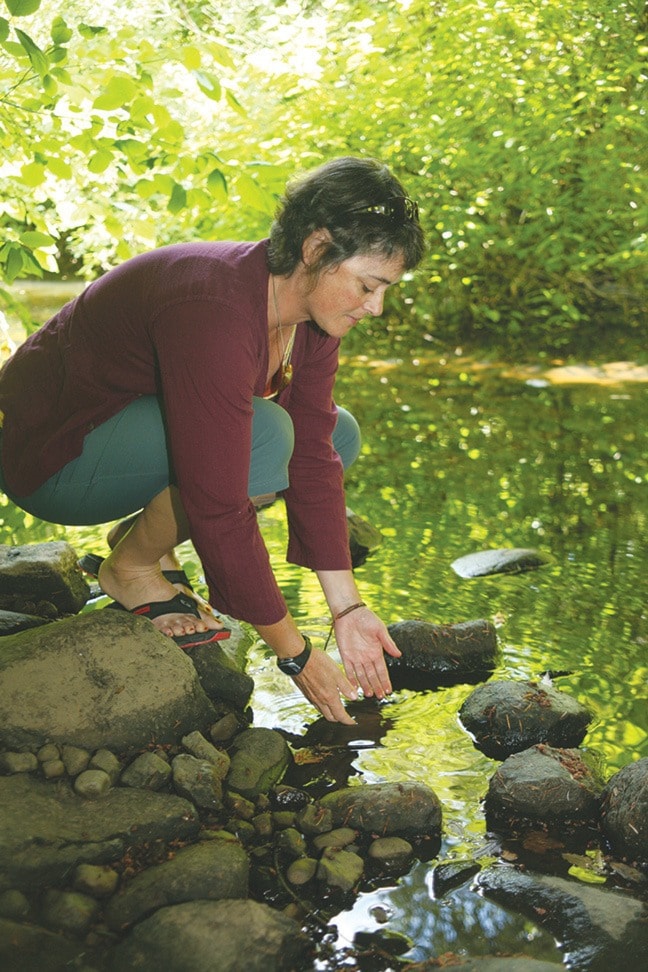Erin Haluschak
Record staff
With the possibility of the Tsolum River dropping below levels that can support healthy fish populations, water - or the lack of it - is having an impact on the future growth of salmon, trout and other freshwater fish.
Angela Spooner is the project co-ordinator for the Tsolum River Restoration Society - an organization that promotes sustainable stewardship of the watershed, along with protecting the river from activities which damage its health, and restore and/or mitigate for lost or damaged habitat.
Along with vice-president David Morwood, Spooner explains this year’s low water levels, combined with elevated water temperatures, is a bad situation not only for the river itself, but for the fish who call the river home.
“Historical practices on the watershed have amounted to large amounts of gravel upstream to downstream. The Tsolum has very shallow drainage and it meanders - with slower velocity - and gravel fills the bars,” she notes.
“Out-migrating fish and coho smolts and other species that need summer refuge in the river are caught in pools and channels that have become isolated from the main channels. To some degree this is natural, but it’s exacerbated.”
Morwood adds the low levels allow the river to lose conductivity between pools and fish lose their food sources.
“It’s tough and it came on quickly. Is this the new normal? Water resources are not up for this kind of stress.”
Additionally, says Spooner, the record-setting June temperatures - which resemble July temperatures - are sustaining, and as a result, elevating water temperatures. The higher the water temperature, the more susceptible the fish are to disease, she adds.
“A general drop in water levels is tough,” notes Morwood. “We need to better manage water and learn how to keep it on the land longer.”
Spooner explains even though the area saw abundant precipitation in the form of rain earlier this year, it’s just not enough without a substantial mountain snowpack.
When it falls as snow at higher elevations, it feeds into the river during the all-important summer months, she adds.
Spooner says there are some things that can be done to help the river and its fish that call it home. The society and various streamkeeper groups around the Island attempt to rescue the fish that are stranded in pools and move them to safer water.
Additionally, riparian zone management can provide shade on riverbanks, protect fish from predators and help with food availability for all stages of fish, she explains.
Due to concerted community efforts, river habitat is improving in the area’s rivers and the salvaged fry are increasingly important in repopulating the new niches made available to them.
Despite the efforts of the fry and smolt salvage, the organization requires more volunteers. To aid in the fry and smelt salvage or to volunteer with the society, visit tsolumriver.org to call 250-897-4670.
• • •
With near-drought conditions hitting Vancouver Island and the west coast of North America, water levels in all major Comox Valley rivers and lakes are receding substantially.
“We are in a level of dryness for this time of year in the Comox Valley that no one could have imagined,” says Stephen Watson of BC Hydro. “The water inflows into the Comox Lake reservoir have now dropped to basically a trickle.”
Supplying power generation to the area, the Puntledge River hydroelectric system was shut down by the company June 16; it had been providing a water release of 12 m3/s down the river system.
“That plan is now obsolete given the stunning drop in water abundance,” Watson notes.
With the lowest snowpack on record, Watson explains the area received a double hit with a record-dry May and June. Within the two months, the Comox Valley received 15 mm of precipitation. Water inflows into the reservoir in May were 29 per cent of normal levels, and in June 17 per cent of normal levels.
“There’s little water coming into the reservoir; where there is some, the surface evaporation rates are eliminating most of it. To put it in perspective, the previous record low water inflow rate into the Comox Lake reservoir for this time of year was 10m3/s back in 2009,” he says.
“Our records go back 52 years and to break it in such a manner is hard to believe.”
Watson says the only control measure available for rising water temperature is to keep as much water storage in the reservoir for the months ahead, while also providing just enough water for river fish habitat.
Given the very low water conditions and the weather, water temperatures will be a big concern potentially into the early fall.
He adds from now until September 30, BC Hydro is modelling an average water inflow rate of only 1 m3/s - an absolute worst-case scenario.
Stage 3 restrictions kick in Friday, the Comox Valley Regional District will implement Stage 3 water restrictions until further notice.
Due to the extremely low water levels, seasonal water activities which are prohibited during the retractions include watering lawns (with manual or automatic sprinklers), filling or adding water to a hot tub or garden pond and washing a vehicle or boat.
